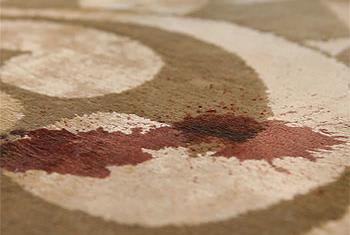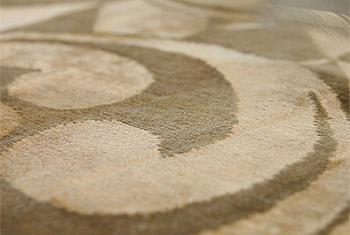
Connections between the Bull's-Gall and Vacuum Cleaners in the Recent History of Carpet Cleaning.
Carpets, rugs, upholstery, and drapes are probably amongst your most important possessions. The aim of this article is to describe the history of carpet cleaning and the science in its background, in order to help the reader better understand the importance behind carpet cleaning.
The first evidence of carpet cleaning procedures dates back to the 19th century. These procedures were an outcome of the Industrial Revolution, when new ideas began to have an impact on the cleanliness of houses in major European and North American cities. Up until then, it was fashionable to protect the carpets by covering their 'problematic' areas with druggets - heavy woolen goods spread under tables and other areas of heavy wear. This would give protection against spills and run-out.
Moreover, the wealthiest classes in Europe used to cover all house carpet surfacing with canvas cloth during major, in-house events or long absences.
Due to lack of a proper ventilation infrastructure, houses of that era were filled with dust and soot, which led to the search for more diligent ways to clean houses, and later on, offices and businesses. At that time, people were adorning their homes with carpets, as sign of affluence, so wanting to keep them in good condition was important. The most common technique for carpet cleaning, at this time, was to beat the carpet with corn brooms in order to get rid of the sand, dust and soot. Of course, this technique was ineffective when it came to stain removal.
In house maintenance journals dating back to the 1830's, creative housewives and expert house holders wrote down their tried-and-tested tips for the removal of ink, oil and grease stains. One method commonly used involved scrubbing the carpet with lemon juice and a hot loaf of crusty white bread. The carpet was then rinsed thoroughly with fresh water and left outside to dry, providing the weather was good.
Cleaning techniques improved over time, including tea leaves brushed into the floor, which stained the carpets. Straw brooms helped preserve the original colors of the carpets. Advice as to the frequency of necessary cleaning was then published, discussing how carpets needed to be 'broomed' in order to prevent run-out and ripping. By the 1880's, more sophisticated advice on carpet cleaning was being published. One such advised mixing water and bull's gall (using a ratio of 3:1 portions), scrubbing the carpet with a flannel cloth then, finally, rinsing it with fresh water.
The bull's gall used contained oxalic salts, that when mixed with water, formed oxalic acid, an acid produced by the body for the metabolism of fatty acids and proteins. This is described as formula H2C2O4, a relatively strong organic acid, about 10,000 times stronger than acetic acid. Oxalic Acid is produced, today, from plants, or by a chemical reaction of sucrose oxidation, and is used in furniture restoration, surface cleaning and rust removal.
As time went on, people had begun using refined oil products, especially Naphtha, both for removing cleaning stains from carpets and also as a pesticide. Even so, the most common technique still used was the mechanical beating of carpets. With time, newer techniques for the restoration of carpets came into fashion, such as a re-painting of the carpet. Unfortunately, this often led to shrinking. Other recommended techniques included clay paste (mixed with water) which would be left on the carpet for few hours - or overnight - to dry. Once the paste was swept off, stains and soil would be removed. An alternative to this paste, which sometimes caused color fading, was chloroform (an organic solvent used for the extraction of compounds from plants and tissues). However, since chloroform also has a paralyzing effect on the central nervous system, this technique was too dangerous to become a prevalent technique.
The next great leap in the history of carpet cleaning took place in the 1870's, when the first manual vacuum cleaner was invented. Electrically powered, and a scientific achievement of the day, peoples' lives became far easier. The first manually-powered cleaner using vacuum principles was the 'Whirlwind.' Invented in Chicago, in 1868 by Ives W. McGaffey, it was lightweight and compact. However, it was difficult to operate because of the need to turn a hand crank whilst pushing it across the floor. McGaffey was but one of many 19th-century inventors in the United States and Europe who devised manual vacuum cleaners.
The first patent for an electrically-driven 'carpet sweeper and dust gatherer' was granted to Corinne Dufour of Savannah, Georgia in December 1900. The first powered cleaner employing a vacuum was patented and produced by Hubert Cecil Booth in 1901. Booth had noticed a device used in trains that blew dust off chairs, and thought it would be much more useful to use one that sucked up dust. He tested the idea by laying a handkerchief on the seat of a dinner chair, putting his mouth to the handkerchief, and then trying to suck up as much dust as he could onto the handkerchief. Upon seeing the dust and dirt that had collected on the underside of the handkerchief, he realized the idea could work. Booth created a large device, known as Puffing Billy, driven first by an oil engine, and later by an electric motor. It was drawn by horses and parked outside the building to be cleaned.
In 1910, P.A. Fisker patented a vacuum cleaner named Nilfisk. It was the first electric vacuum cleaner to be used in Europe. His design weighed just 17.5 kg and could be operated by a single person. In 1905, "Griffith's Improved Vacuum Apparatus for Removing Dust from Carpets" was sold as a manually-operated cleaner, patented by Walter Griffiths Manufacturer, Birmingham, England. It was portable, easy to store, and powered by "any one person (such as the ordinary domestic servant)", who would have the task of compressing a bellows-like contraption to suck up dust through a removable, flexible pipe, to which a variety of shaped nozzles could be attached. This was arguably the first domestic vacuum-cleaning device to resemble the modern vacuum cleaner.
In 1907, James Murray Spangler, a janitor in Canton, Ohio invented an electric vacuum cleaner from a fan, a box, and a pillowcase. In addition to suction, Spangler's design incorporated a rotating brush to loosen debris, which has added during the 1960's. His vacuum sold under the name 'Model O' with a price of about $60. Spangler patented his rotating-brush design in 1908, and eventually sold the idea to his cousin's husband's "Hoover Harness and Leather Goods Factory." Their first-produced vacuum was the hand-built 'Model O'. The basic premise behind the vacuum cleaner was its suction, caused by a difference in air pressure. A pump reduced the pressure inside the tube, atmospheric pressure then pushed the air through the carpet and into the tube, the dust literally being pushed into the bag.
In the 1920's/30's, no new cleaning method was invented for carpets, which had fallen out of style. However, accepted wisdom was that rugs were to be well-vacuumed before being shampooed, using an ample supply of soap jelly, a large bowl, an egg beater, a soft scrub brush, 2 pails of clean water, and a number of clean cloths.
"If the work is to be done in the house, the floor beneath should also be cleaned. The rug can be shampooed lying on the floor, but there is greater convenience in having a small table over which it can be drawn section by section, with care to work over the edge of the first to prevent the leaving of an unwashed streak. When cleaned, the rug should be hung outdoors in the shade to dry. Should this not be possible, it should be supported on chair backs, and all windows opened to admit plenty of air. When dry, the nap should be brushed in one direction with a stiff broom.
During World War II, research took on a more medical direction, but the uses of chemicals found and invented brought about what is known as the modern era of carpet cleaning. Today, the same basic principles used after 1945 are still in use, only improved and more efficient.
Remember: Professional cleaning of a carpet on a regular basis will extend its life expectancy considerably, in addition to keeping it hygienic and looking good. Not cleaning a carpet correctly, or not cleaning it at all, will reduce its life expectancy significantly.
References:
- Historic carpet cleaning methods in the nineteenth and twentieth centuries. Burrows, John. J.R. Burrows & Company. (www.burrows.com/carpetcleaning)
- en.wikipedia.org/wiki/Vacuum_cleaner
Special Offers
Quick Contact
Before & After






























